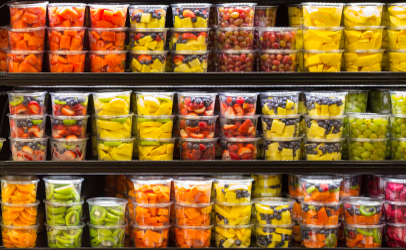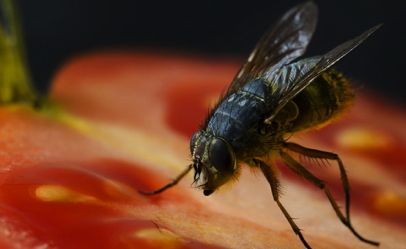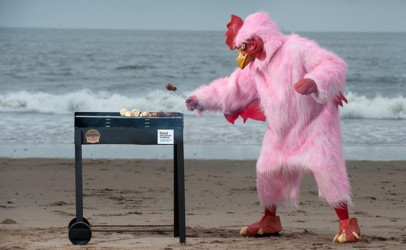Just as feathered birds head south for warmer weather, so, too, do human snowbirds, who pack up their RVs and travel trailers they call home once they get to their sunny destinations.
But food-safety gurus warn that there’s no vacation from food safety.
 “I don’t subscribe to the ‘knock-on-wood’ approach to food safety,” said Bill Flynn, food safety manager for Mohave County in Arizona.
“I don’t subscribe to the ‘knock-on-wood’ approach to food safety,” said Bill Flynn, food safety manager for Mohave County in Arizona.
People should follow the same food safety principles at home or in a recreational vehicle, but life on the road presents some different challenges, he said.
“Heat can exacerbate the situation,” Flynn said.
First and foremost, he said, don’t “temperature abuse” your foods. Keep hot foods hot and cold foods cold. And beware of the “danger zone” — temperatures between 40 and 140 degrees — where bacteria grow most rapidly, making them more likely to cause illness and infection in people who eat contaminated food.
When hosting a dinner, picnicking or throwing a potluck, it might be tempting to leave food out on tables or on the counter so people can go back for seconds. But Flynn noted that in warmer climates, especially, any bacteria that might be on the food can quickly reproduce to dangerous levels. Rule of thumb: Put the food into the fridge after two hours — one when eating outdoors and temperatures hit 90 degrees F or higher.
Bottom line: Keep cold foods on ice and hot foods over some sort of warmer if they’re left out for guests.
Cooking food in a microwave takes some food safety know-how, too, especially in the case of meat, poultry, fish or frozen dinners. Once it’s out of the microwave, cover loosely with aluminum foil and let it “rest” for two minutes. That way it will keep cooking, which allows all parts of the food to reach the correct temperature.
Kevin Broom, spokesman for the Recreation Vehicle Industry Association said RV’ers should make sure they have an adequate supply of propane to run their refrigerators when they’re on the road. RV refrigerators typically use propane when driving down the road, and electricity when hooked up to power in a campground or trailer court.
‘Danger’ foods
Nutrition experts encourage people to eat plenty of greens, but be careful with raw cut salad greens, including baby spinach. They need to be kept at 41 degrees or cooler to prevent bacteria from migrating to nutrients that are oozing out of the cuts on the greens. From there, the bacteria begin to reproduce rapidly. No amount of washing will flush all of them off fresh produce.
 Then there are the ready-to-eat”foods such as hot dogs, meat spreads, freshcut cantaloupe and raw sprouts, among others.
Then there are the ready-to-eat”foods such as hot dogs, meat spreads, freshcut cantaloupe and raw sprouts, among others.
“I wouldn’t hold them for more than several days because of listeria,” said Flynn. “There are inherent risks that come with them even if they’re refrigerated.”
Listeria can grow even in the cold temperature of the refrigerator. It can survive freezing temperatures, too. It is killed by cooking and pasteurization. Symptoms of listeriosis are a stiff neck, confusion, weakness and vomiting, sometimes preceded by diarrhea. It can take up to 70 days after exposure for symptoms to develop.
Salmonella and E. coli are other foodborne pathogens that can contaminate pre-cut fruit and vegetables. According to the Australian Institute of Food Safety pre-cut fruit is one of the most common foods associated with foodborne illnesses. Eating whole fruits is obviously a better option, say food-safety gurus.
Perhaps surprisingly, a lot of raw fruits and berries carry a high risk of food poisoning, according to the institute. Listeria in particular can grow on the skins of fruits and vegetables, and Salmonella has been found responsible for more and more cases of food poisoning traced back to berries, hot peppers and tomatoes.
Melons also can be high risk, because they grown on the ground and may not be washed before eating. Harmful substances can easily be transferred to the flesh of the fruit anytime throughout the supply chain process, as well as when the melons are cut.
Rule of thumb: Wash all produce, and in the case of fruits and vegetables with hard skins such as cantaloupe and cucumbers, rub them or use a vegetable brush while cleaning them under running water. Always dry the produce with a clean cloth or paper towel after washing it and before cutting it open.
Left0vers
As for that leftover rice, it’s actually considered a high-risk food because it can get infected with bacillus cereus, which can actually live in uncooked rice as spores. Cooking it activates the bacteria, and moist cooked rice is the perfect breeding ground for harmful bacteria.
 “Not storing cooked rice properly is one of the biggest culprits of foodborne illnesses in the world,” according to the Australian Institute of Food Safety.
“Not storing cooked rice properly is one of the biggest culprits of foodborne illnesses in the world,” according to the Australian Institute of Food Safety.
“All cooked rice should be stored in the refrigerator at the correct temperature, (41 degrees or colder), to avoid the further growth of bacteria,” advises the institute. Rice that has high-risk proteins in it, for example pork or egg, carries an even higher risk of contamination.
Leftovers in general are a challenge, according to food safety professionals.
“You don’t want to hold them too long,” said Flynn, whether they’re home-cooked or from a restaurant.
And when in doubt, he said, throw it out.
Previously cooked leftovers should be heated to at least 165 degrees F. In the case of sauces, soups and gravy, USDA’s advice is to bring them to a boil when reheating.
Older adults should heat all deli-style meats, according to the the Academy of Nutrition and Dietetics.
As in any cooking situation, it’s important to use a food thermometer to check that what you’re cooking has reached the right temperature. Food that might look well-done on the surface might not be thoroughly cooked on the inside.
Tight spaces
Tight spaces are something else RV’ers contend with — so different from being at home where there’s a lot of room.
“In tight spaces, cross contamination can be all over the place,” Flynn said.
That’s why it’s so important to keep meat and poultry away from produce and other foods you’ll be eating raw. Knives, cutting boards, counter tops, and even your own hands, can be sources of cross-contamination.
An RV veteran, who goes by the name of Timetraveler2, agrees.
“People fall in love with the idea of RVs; they look like houses,” she said. “But space is limited, and cross-contamination can be a problem.”
 Don’t get ‘bugged’
Don’t get ‘bugged’
Timetraveler2 also pointed out that each region of the country is different. For example, while Arizona is arid and dry, Florida’s climate is hot and humid and home to more bugs than the arid Southwest.
“You do have to watch out for them,” she said. “RVs are not like houses. It’s very easy for bugs and vermin to get into an RV and then into any food that isn’t sealed.”
She advises hiding ant and roach traps in closets; spraying RV tires, hoses and front panels with Pam to makes potential entryways slippery; and making sure RV screens don’t have any holes in them. It also goes without saying, that you need to make sure any poisons you might be using don’t accidentally end up on cooking surfaces or in food.
Recent research published in Scientific Reports reveals that house flies and blowflies carry more diseases than suspected. Many of those bacteria are linked to human infections, among them stomach bugs, blood poisoning and pneumonia.
According to the research, every step taken by a fly can transfer live bacteria.
That’s yet another good reason not to leave fruit or vegetables out on the picnic table, even though you might do that in your home dining room. That, of course, goes for meat and fish as well.
Humid climates trigger mold and mildew, which is another food safety concern.
Temperature
Because RVs are generally not as insulated as houses, the temperature of the outdoor air needs to be taken into consideration.
“Your refrigerator and freezer are affected by the outside temperature,” Timetraveler2 says, adding that changing temperature settings in RV refrigerators according to weather conditions is necessary.
Vintage trailer enthusiast Cherri Aiken advises people to keep a thermometer in their RV refrigerator. Mohave County food-safety official Flynn agrees.
“Otherwise how will you know what the temperature in your refrigerator really is?” Flynn said.

Out in the boonies
Many RVers enjoy camping out in the boonies. Timetraveler 2 said that’s even more of a reason to be especially careful about food safety. If an emergency should arise, you’ll often be far from a hospital or medical care.
She also pointed out that many RVers are older and therefore more vulnerable to food poisoning. When in remote areas, it can be fun to cook over an open fire. But, she said, you need to know what you’re doing.
“At home you know your equipment,” she said. “It’s different from cooking over an open fire.”
She also advises that if you’re going to go fishing, make sure you know how to gut, clean and cook a fish properly.
“Take the time to do your research,” she said.
Broom said that RVers camping in remote areas should make sure to securely close cabinets, food storage areas and refrigerators, and dispose of waste securely to avoid attracting raccoons, bears or other wildlife.
Packing the food
Timetraveler2 likes to start out fresh for each trip — packing everything new.
Another tip from this veteran RVer: Once a box of dry food such as cereal has been opened, repack what you haven’t eaten into sealable airtight plastic containers. This protects the food from mildew, water damage, bugs and vermin and also helps to keep it fresh.
Avoid glass containers if possible, simply because you don’t want any broken glass to get into your food.
As for refrigerated foods, she advises they be packed as tightly as possible.
 Also important: Make sure your RV is level each and every time you park so that the refrigerator will continue to operate.
Also important: Make sure your RV is level each and every time you park so that the refrigerator will continue to operate.
RVers Al and Lori Pratt like to pack some nonfat dry milk not only because it saves space but also because they don’t have to worry about whether any liquid milk is spoiling.
Sometimes substitutes come in handy. While the Pratts like their bacon, they often pack some Spam and fry it up along with some eggs for breakfast, just in case they’ve haven’t eaten the bacon relatively soon after opening it.
The USDA advises that meat, poultry and seafood should be packed while it’s still frozen so it will stay colder longer. Another piece of advice: Wrap those foods securely so their juices don’t drip onto foods such as veggies and fruits that will be eaten raw.
It also warns never to reuse platters or utensils that have previously held raw meat, poultry or seafood until they’ve been washed in hot, soapy water. Otherwise, juices from the raw meat can get onto cooked food and cause food poisoning.
Safe water
Vintage trailer enthusiast Aiken said there are a lot of minerals in the water in some regions. “You don’t always know what the water is like,” she said.
For that reason, she buys gallon jugs of water. “They’re good to use for anything,” she said.
Timetraveler 2 warns that water in some campgrounds can be questionable. “There are a lot of water-borne illnesses,” she said.
She also pointed out that when people are traveling, they’ll be going to places with different types of water. Even if it’s perfectly safe, the water in one place might disagree with you while water in another place will be perfectly fine.
Enjoy
Al Pratt said that while he and Lori make sure they’re not taking any chances with food, there’s nothing all that complicated about it.
“Just use common sense,” he said. “That’s the main thing.”
Timetraveler2 would agree. “Enjoying delicious, healthy foods is one of my favorite things about RV traveling, so make eating a pleasure, rather than a problem.”
(To sign up for a free subscription to Food Safety News, click here.)
